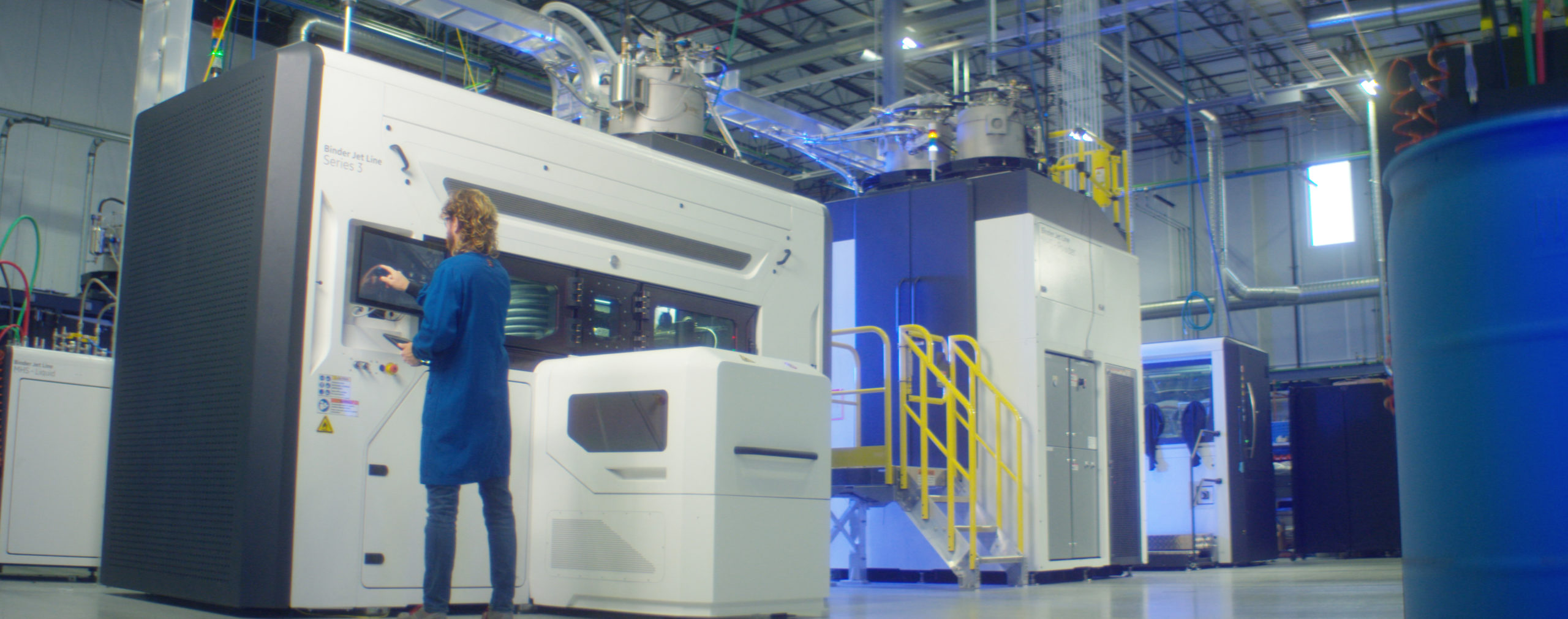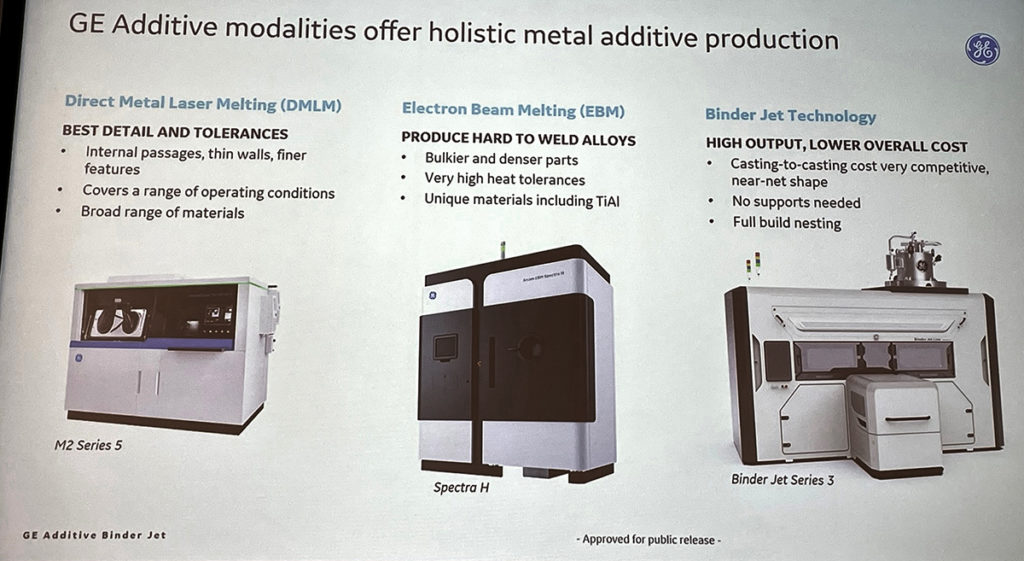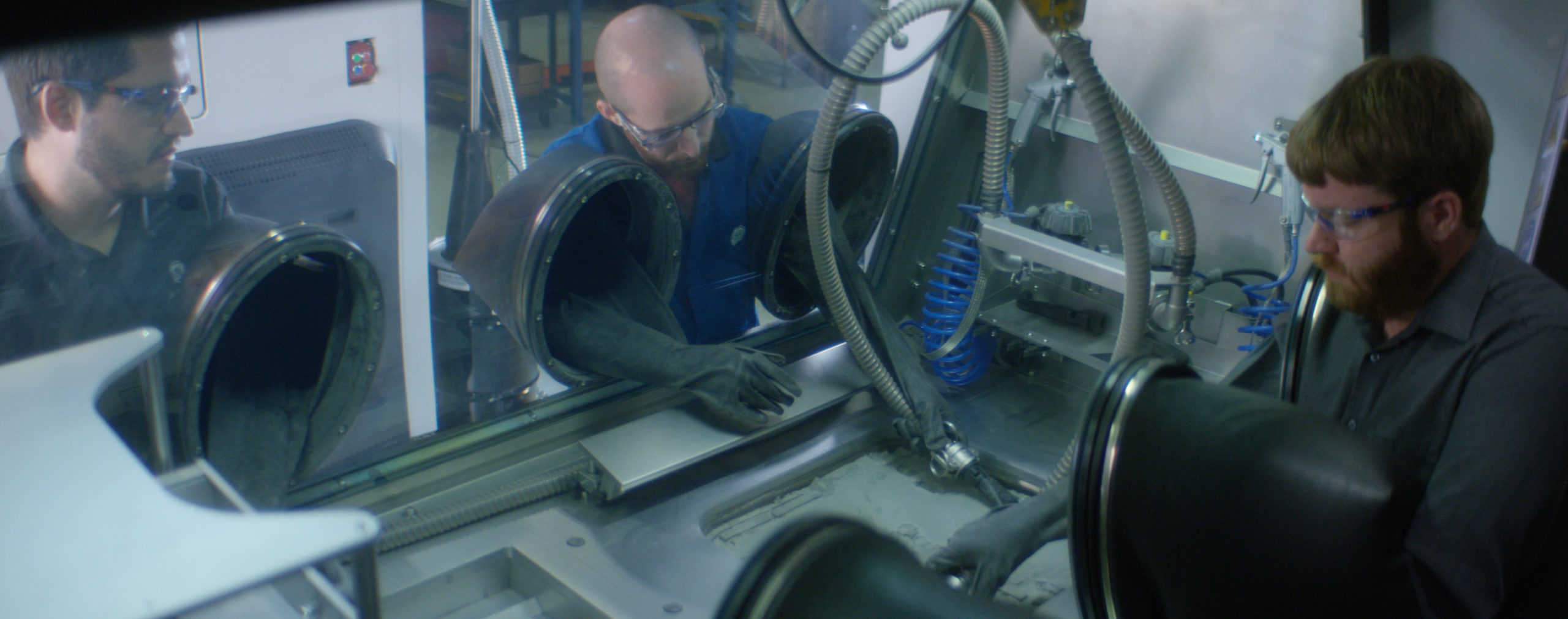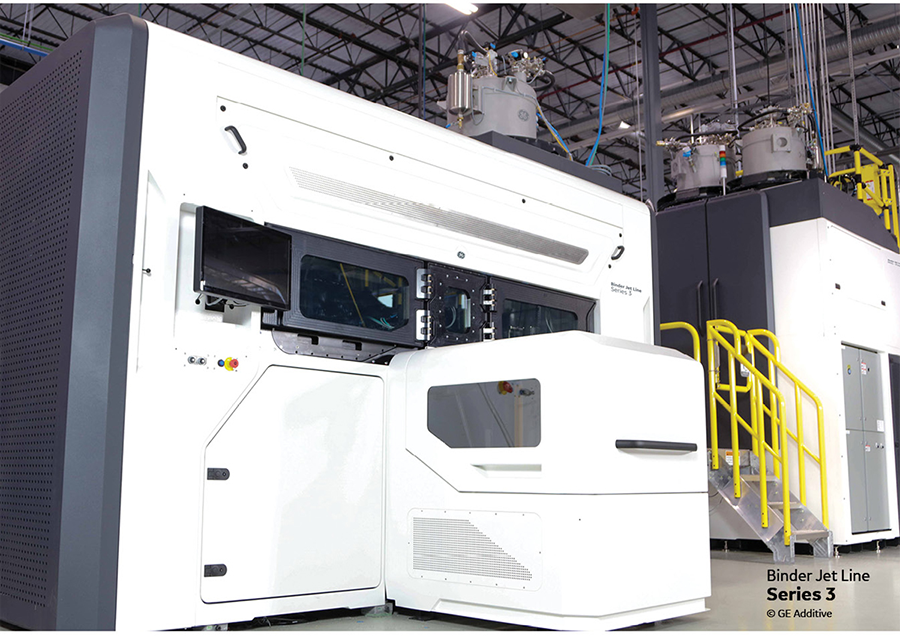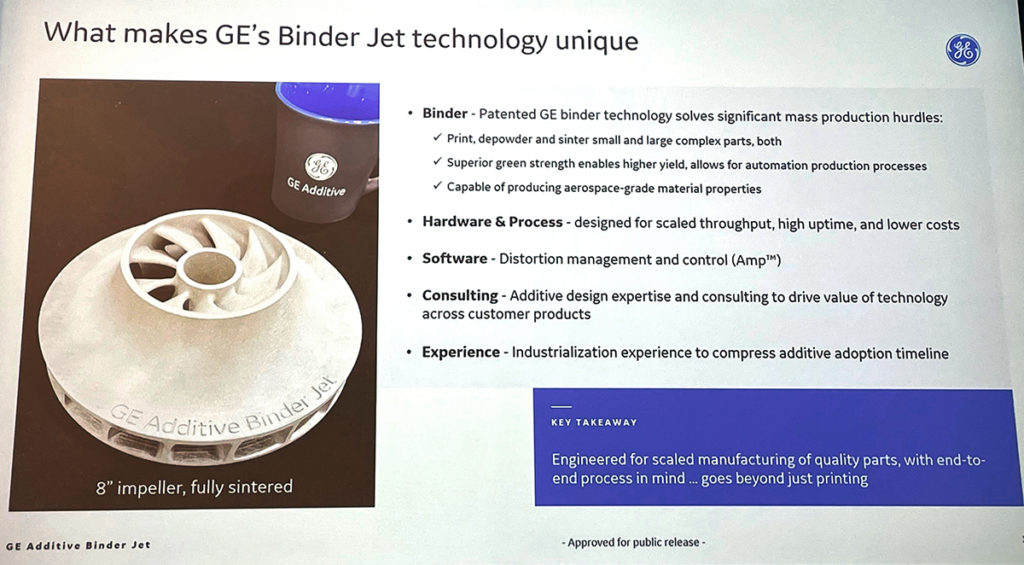After embarking on Project A.T.L.A.S. over five years ago, GE (NYSE: GE) has finally announced the commercial release of the first printer in its binder jet line, the Series 3. Now that it has been tested for use in modern, high-volume, serial production environments, the metal binder jet 3D printer will be ready to ship in the second half of 2023, though some pre-orders are already in the books.
On October 18, 2022, 3DPrint.com had the chance to be in attendance for the unveiling of Series 3 at GE Additive’s facility in West Chester, Ohio.
Developing a New Metal 3D Printing Technology
GE Additive was formed with the acquisition of two manufacturers of metal 3D printer relying on powder bed fusion (PBF) technology, Concept Laser and Arcam. However, PBF – laser in the case of Concept and electron beam in the case of Arcam – both have drawbacks, including high cost and low throughput. Metal binder jetting, therefore, opens up new possibilities for mass production of 3D printed metal parts. Also, contrary to popular belief, it can produce internal passages, you just need a strong enough binder.
The Series 3 was the result of collaboration across all of GE’s business segments, with chemistry development occurring at the GE Research Center and machine designers hailing mostly from GE Aerospace.
“[The program] really started on this in earnest in 2016. The original motivation was to solve problems specifically around casting costs for the GE businesses,” Josh Mook, chief engineer and innovation leader at GE Additive, told the press at the unveiling. “We actually started developing binder jet with our chemistry, working on the chemistry of the binder for a long time before we decided we should get to the hardware, because what was already available wasn’t meeting our needs. We’re focused not only on high speed and throughput, but industrial, factory-level equipment. From my perspective at GE Additive, it’s something that’s been missing from the space for some time.”
Mook noted that binder jet was essential to the company’s dominance in the industry. However, the issue was whether or not the technology should be developed in-house or acquired. When GE pursued the latter option, it dubbed the Series 2 beta system the “H2”. Mook explained why:
“We knew we needed to get into binder jet for rapid consolidation. We had to decide whether we wanted this to be an acquisition or organic? Acquisitions are hard, and we had a bunch of engineers chomping at the bit to build something organic. Probably around 2017, we set aside a small team and gave them 55 days to try and build a machine. That’s why it’s called ‘H.’ H stands for ‘hustle.’ 47 days later, we printed our first part on it. Despite it being such a rapid design-build-test, it proved we had something unique. Now, we’re on the third generation with Series 3. It took us less than three quarters from that first prototype to getting it into the hands of our customers.”
Customer Collaboration
GE’s metal binder jetting technology was developed with key partners over a four-year customer discovery phase that included large companies in a variety of verticals: Cummins for power generation and automotive, Wabtec for rail, Sandvik for mining, and Kennametal for industrial applications when wear and corrosion resistance are critical.
Brian Birkmeyer, product line leader for binder jet at GE Additive, said that, even though the predecessor to the Series 3 was only a beta machine, with a build volume of 380 x 380 x 270 mm, it wound up as a production system for its customers.
“We’ve been working on it continuously, quietly, with select partners, to make sure what we bring to the market works,” Birkmeyer said. “That’s why you see a long timeline. The Series 2 beta was intended to be a beta ahead of the Series 3, but many of our customers have taken it to low-rate production.”
GE will eventually sunset production of the Series 2 development platform, though the company is still actively taking partners for it, and there is a possibility that it could be made more robust in the future. For the time being, the Binder Jet Line represents the complete equipment suite, while the Series 3 is the printer in that suite.
How Does the Binder Jet Line Work?
GE’s binder jet technology sees a water-based binder deposited onto a bed of powder. The water is then heated so that it evaporates before the remaining material is cross-linked to create a semi-solid composite, or “green”, part. The Series 3 then pulls any moisture that’s been driven out of the printing process and uses it as a part of the machine’s cleaning agent. It can not only print with inert or reactive metals, but also composites and ceramics.
As a part of the Binder Jet Line, there are three pieces of ancillary equipment that can support multiple machines and don’t have to be located immediately next to the Series 3. The Liquid MHS acts as a vehicle for binder and cleaner for active printhead maintenance and features three barrels, one for binder, one for low-cost cleaner, and another for waste made up mostly of contaminated cleaner that is no longer viable.
The Powder MHS includes two hoppers for virgin and recycled powder, co-developed with sister business AP&C, and uses pneumatic compressors to move about 25 kg per minute to the Series 3 machine. Raw powder is shipped in UN-approved drums and connected directly to the machine, meaning that no human operator is required to initiate this process. The machine sucks the powder out, and ejects it into the virgin powder hopper while recycled material is put into the recycled powder hopper. Seeing this process in-person on GE Additive’s shop floor was pretty amazing.
Series 3 Features
According to the company, the Series 3 is able to overcome an issue faced with binder jetting more generally: the production of large parts. Typically, big prints can become too heavy for the binder jet process, resulting in a collapse. Sintering, which is a complex issue for parts of any size, is that much more difficult to predict and successfully accomplish with oversized components.
GE Additive claims that the Series 3, with a build volume of 500 x 500 x 500 mm, can repeatably and reliably produce parts “that exceed casting equivalents,” while obtaining through-hole diameters and wall thicknesses of less than 500 μm. Items weighing as much as 25 kg in stainless steel have been successfully produced, with no known maximum limit for wall thickness. The printer was also built with serviceability in mind, so it’s easy to fix a nozzle or a printer that’s worn out. It’s also an open material system.
De-powdering can also be accomplished without destroying fine features. Additionally, GE Additive’s Amp software features distortion prediction and compensation, making it possible to sinter parts within desired tolerances.
The cost of the Series 3 has not yet been made public, but GE boasts the ability of the technology to produce parts at a total cost of ownership that makes it competitive with conventional manufacturing. Some cost efficiency is achieved by recycling unused powder and relying on less expensive materials compared to those used in powder bed fusion (PBF). Additionally, the entire build box can be utilized without the need for support structures.
GE expects that users may eventually be able to deploy fleets of 40, 50, and even 100 systems, which will further ensure repeatable process quality and reduce operator contact with equipment and materials. The “automation readiness” and “seamless… integration into factory cells” of Series 3 means that such an environment could be made that much more efficient through the use of robotics and other automation technologies. Among the automation features is a conveyor system that comes in and out of the machine to potentially separate such functions de-powdering and sintering. Additionally, each build box has a serial number, which the machine scans to ensure proper tracking of lots.
Altogether, GE claims that its system is up to 100 times faster than “other additive manufacturing modalities,” which we can assume refers to laser PBF. The Series 3 also doesn’t require the same hazard zoning as PBF. It will be UL listed and CE certified, with a 100-percent inert and sealed environment, as well as fully closed loop powder-free exposure. Built-in sensors detect leaks and put the machine into a safe state. Each part of the system is the same, but each configuration is custom to the customer.
GE’s Binder Jet in the Market Place
At the moment, there are only a handful of metal binder jet printer manufacturers in the industry. Most notably, Desktop Metal has the largest market share through its acquisition of ExOne and includes former GE CEO Jeff Immelt on its board, alongside Steve Nigro, former President of HP’s 3D printing business. This is followed by Markforged, which purchased Digital Metal from Höganäs AB. HP has just released its MetalJet technology commercially at IMTS and, if its history with polymer 3D printing is any indicator, should be able to scale up this business quickly. Now, we have GE, one of the largest companies in the U.S. with 2021 revenues of $74.196 billion.
SmarTech Analysis Executive Vice President of Research Scott Dunham provided his outlook on the metal binder jetting segment earlier this year, while SmarTech projected more broadly that, by 2030, the 3D printing of metal parts with binder jet would be worth $54B. Regardless of who comes out on top, GE will certainly have access to a larger piece of the pie by virtue of the fact that it not only makes machines for multiple metal AM segments, but the powders as well, via AP&C.
Subscribe to Our Email Newsletter
Stay up-to-date on all the latest news from the 3D printing industry and receive information and offers from third party vendors.
You May Also Like
Gorilla Sports GE’s First 3D Printed Titanium Cast
How do you help a gorilla with a broken arm? Sounds like the start of a bad joke a zookeeper might tell, but it’s an actual dilemma recently faced by...
Nylon 3D Printed Parts Made More Functional with Coatings & Colors
Parts 3D printed from polyamide (PA, Nylon) 12 using powder bed fusion (PBF) are a mainstay in the additive manufacturing (AM) industry. While post-finishing processes have improved the porosity of...
$25M to Back Sintavia’s Largest Expansion of Metal 3D Printing Capacity Since 2019
Sintavia, the digital manufacturing company specializing in mission-critical parts for strategic sectors, announced a $25 million investment to increase its production capacity, the largest expansion to its operations since 2019....
Velo3D Initiates Public Offering in a Bid to Strengthen Financial Foundations and Drive Future Growth
Velo3D (NYSE: VLD) has been among a number of publicly traded 3D printing firms that have attempted to weather the current macroeconomic climate. After posting a challenging financial report for 2023,...


